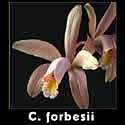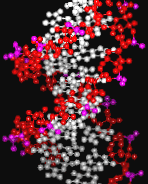 KAP WebNotes
KAP WebNotes
Genes,
Environment, and Chance
The character of
all
living organisms result from the interaction of environment
and
genes.
For example, the risk of colon cancer is increased by dietary factors
such
as high fat and low fiber. But a certain genetic allele
(version of a gene sequence) in certain individuals confers a high risk
of colon cancer, even with a low-risk diet.
| A
SAMPLING OF ENVIRONMENTAL GENES |
| Polymorphism |
Class |
Environmental
exposure |
Associated disease |
| CYP1A1 |
Activation |
Smoking |
Lung cancer |
| NAT2 |
Detoxification |
Smoking |
Bladder, breast cancer |
| GSTT1 (null) |
Detoxification |
Chlorinated solvents |
Cancer, toxicity |
| Paraoxonase |
Detoxification |
Nerve agents, pesticides |
Nervous system damage |
| HLA-H |
Nutritional factors |
Iron in diet |
Hemochromatosis |
TGF- |
Growth factor |
Maternal smoking |
Cleft lip & palate |
| Locus on
chrom. 17 in
mice |
Immune/inflammatory
response |
Ozone |
Lung inflammation |
| HLA-DP bet1
marker |
Immune response |
Beryllium |
Chronic beryllium disease
(lung
disorder) |
| ALAD |
Biosynthesis |
Lead |
Lead poisoning |
Jocelyn
Kaiser,
Science
Magazine, 278:569 - 570, 24 Oct 1997
Genes contain the
information
of a cell that is inherited by future cells. Each cell needs to
copy
its chromosome exactly and pass on an identical copy to each daughter
cell.
Of course rare "mistakes" occur -- cells
actually
have evolved to favor rare mistakes.Why?
(See Week 8, Molecular Evolution)
Experiments
designed
to demonstrate the genetic or environmental component of a trait
generally
aim to keep all components constant except the one tested. As a
result,
someone who studies Down's Syndrome might conclude that the basis of
intelligence
is genetics; whereas someone studying lead poisoning would conclude
that
the basis of intelligence is environmental. Actually, all traits --
appearance,
development, behavior -- depend on BOTH genes and environment.
Chance
also determines the development of an organism. For example individuals
with the chromosome abnormality of Down's Syndrome may develop by
chance
to a wide range of levels -- some develop so badly they die before
birth;
others have severe heart defects and other physical problems; mental
delays
vary from severe to minor; some show few physical problems, and can
attend
college. None of this variation can be predicted from the genes, only
from
chance effects in development.
Levels of
organization
in living systems
The content of the
Biology
core courses can be viewed as a continuum:
History
of Genetics
For thousands of
years,
humans have acted as agents of genetic selection, by breeding offspring
with desired traits. All our domesticated animals (dogs, horses,
cattle)
and food crops (wheat, corn) are the result.
Yet for most of
this
time, humans had no idea how traits were inherited. Why?
Offspring resemble
parents (or don't) in bewilderingly complex ways. That is because
individuals in nature contain many genes,
and many different versions (alleles)
of each gene. Consider these three individual orchids:
Orchid
Photos
-
What
happens when you breed them? Try it out -- Orchid
cross. (To cross, click on one of the orchids.)
In
1866, Gregor Mendel discovered independent assortment of
traits,
dominant and recessive expression. Traits appear in pairs; separate
independently
in the gametes; recombine in pairs, in offspring. (Today we know Mendel
only studied unlinked traits: on separate chromosomes, or so far apart
that crossover frequency approached 50%).
But Mendel's work
was
lost. Only in the past century did humans learn the fundamental
mechanisms
of heredity:
How and why
organisms
resemble their parents; and how the inherited information functions to
make organisms look and behave as they do.
| 1902
--
Walter Sutton and Theodore Boveri, using dyes synthesized by
the German organic chemistry industry, observed that "colored bodies"
in
cells behaved in ways parallel to the hypothetical agents of heredity
proposed
by Mendel. These bodies were called chromosomes.
1905
--
Nettie Stevens observed in Tenebrio beetles that all
pairs of homologous chromosomes are the same size, except for one pair
which determines sex -- X, Y.
1909
--
Thomas H. Morgan correlates the X chromosome with sex-linked
inheritance of the white eye trait in
Drosophila -- a strain of
flies discovered by an undergraduate lab assistant, cleaning out old
bottles
of flies in Morgan's lab. Morgan went on to make many important
discoveries
in fly genetics and linkage analysis that apply to all diploid
organisms.
1941
--
Beadle and Tatum determined in Neurospora that each gene
encodes
one product (protein). (Later, we learned that RNA can be a product,
not
always transcribed to protein; for example, a ribosomal RNA.)
1944
--
Oswald Avery identified DNA as the genetic material. Pieces
of DNA can transfer genes into bacteria cells, and transform them
genetically.
|
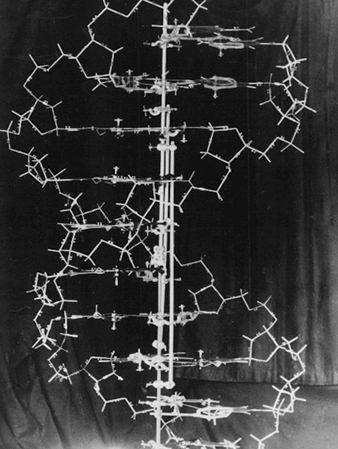 |
1953
--
Thomas Watson and Frances Crick determined the double-helical
structure
of DNA, and the structure of the base pairs which enable replication
producing
two identical daughter helices.
1961
--
Jacob and Monod figured out regulation of the lac operon.
1960's
--
Barbara McClintockdiscovered transposable elements in corn;
later
found in bacteria and animals.
1970
--
Temin and Balitimore discovered reverse transcriptase in
retroviruses;
an enzyme later used to clone genes based on the RNA encoding the
product.
1977
--
Maxam, Gilbert, Sanger, others -- developed methods to sequence
DNA.
|
| 1981
--
The
first transgenic mammals were made.
1987
--
Kary Mullis invented the polymerase chain reaction (PCR), using
a thermostable enzyme from a thermophilic bacterium discovered by
Thomas
Brock at a geyser in Yellowstone. Mullis sold the process to a
pharmaceutical
company, and earned very little. Brock didn't earn a cent.
1995
--
The
first bacterial genome sequence, Haemophilus influenzae, was completely
determined.
1996
--
Ian Wilmut
cloned the lamb Dolly
from adult mammary gland tissue.
1999
--
Completion
of the first sequence of a human chromosome, number 22.
2002
--Completion
of the human genome?
2010
--
Whole organs grown in culture?
2020
--
Chimp/human hybrids demand human rights?
2050
--
Self-aware computers demand human rights?
|
Genomes
A genome
is the total of all genetic sequence in an organism. See The
Human Genome Project.
The genome of Escherichia
coli contains 4.6 million base pairs, encoding 4,400 genes.
The human genome
contains
3 billion base pairs in the nucleus, but only 60,000 genes (estimated),
taking up 3% of the sequence. The rest includes regulator regions
and large stretches of repetitive sequence of unknown function.
The entire genome
has
been sequenced for several microbes, and for one simple animal, Caenorhabditis
elegans.
Take a closer look
at three genomes:
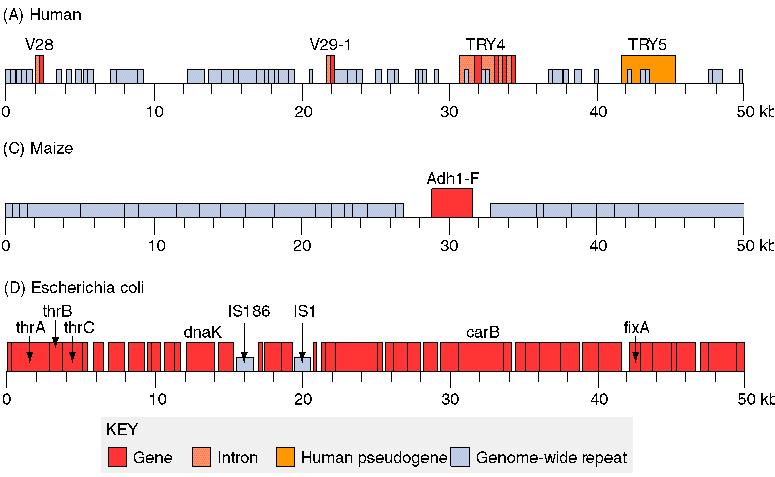
T.
A. Brown,
Genomes, BIOS
-
Genomes of
microbes usually
contain mainly genes encoding proteins.
-
Multicellular
eukaryotes (animals and plants) have their genes interspersed between
large
stretches of repetitive sequence
(Satellite
DNA).
-
Genes
of humans and other eukaryotes are interrupted by introns
of unknown function.
-
As
genomes evolve, some genes accidentally make extra copies, which
degenerate
through mutations, becoming pseudogenes.
Genomes from
different
organisms have a lot in common. Thus, we can use model
systems
to make hypotheses about the biology of humans. We can learn a
surprising
amount of human biology from genomes of yeast, C. elegans, Drosophila,
and the mouse. The latest model genome proposed is the chimpanzee.
-
The chimpanzee's
genome
could give us cancer-resistant genes.
-
To create "model
systems"
for human diseases, we could put human disease genes into chimps.
-
What might the
chimps
have to say about it?
Prokaryotes
Prokaryotic
cells (bacteria) contain their chromosome as circular
DNA. Usually the entire genome
is
a single circle, but often there are extra circles called plasmids.
The
DNA is accessible to enzymes that make RNA and protein (see Week 4, 5).
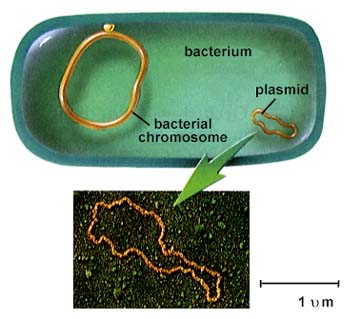
From Bacterial
Diversity
The bacterial DNA
is
packaged in loops back and forth. The bundled DNA is called the nucleoid.
It concentrates the DNA in part of the cell, but it is not separated
by a nuclear membrane (as in eukaryotes.) The DNA does form loops
back and forth to a protein core,
attached
to the cell wall.
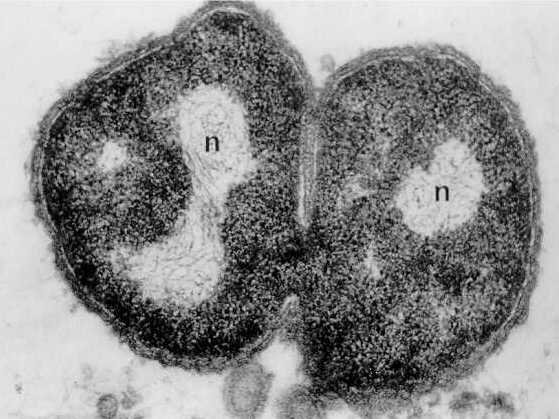
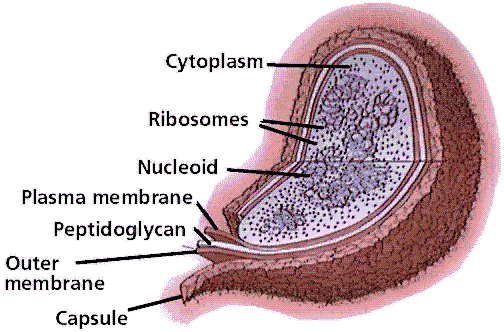
From Bacterial
Diversity
Eukaryotes
Eukaryotic
cells contain their DNA within the nuclear
membrane.
| The
DNA double helix is bound to proteins called histones.
The histones have positively charged (basic) amino acids to bind
the negatively charged (acidic) DNA. Here is an SDS gel of
histone
proteins, separated by size (those migrating down farthest are smaller). |
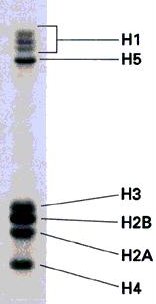 |
From
Virtual
Fly Lab
The
DNA is wrapped around the histone core of eight protein subunits,
forming
the nucleosome.
The nucleosome is clamped by histone H1. About 200 base pairs
(bp)
of DNA coil around one histone. The coil "untwists" so as to
generate
one
negative superturn per nucleosome.
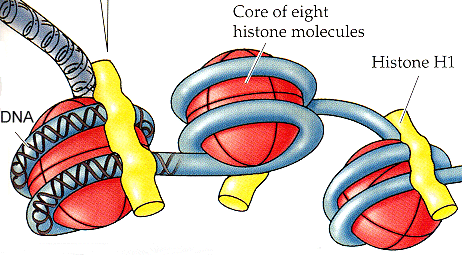
Life, the Science of Biology, by
Purves, Orians, & Heller, 5th ed., 1997
Click on image
to see molecular structure
from Protein
Data Bank (pdb 1aoi)
This
form of DNA is active chromatin;
it can be "expressed" (transcribed and translated) to make RNA and
proteins
(Week 4, 5).
After
DNA has been replicated for mitosis
(cell division), the chromatin condenses.The
nucleosomes zig-zag back and forth to form a flat ribbon:
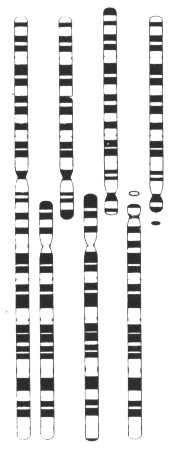
Life, the Science of Biology, by
Purves, Orians, & Heller, 5th ed., 1997
The ribbon forms
a
coil, which then loops back and forth attached to a nuclear
matrix -- similar to the protein core
of bacteria, but greatly extended. During mitosis, several more
layers
of coiling result in fully condensed
chromatin
(see textbook Ch. 9).
In
mitosis, the chromosomes
appear as the thick rod-shaped bodies which can be stained and
visualized
under light microscopy.
The modern way
to
visualize condensed chromosomes is by FISH --
fluorescence in situ hybridization.
In this method, fluorescent antibody-tagged DNA probes hybridize to
their
complementary sequences in the chromosomes. By using FISH probes
with different colored fluorophores, one can color each human
chromosome
independently, and thus identify all 23 chromosomes. This is
called
chromosome
painting. |
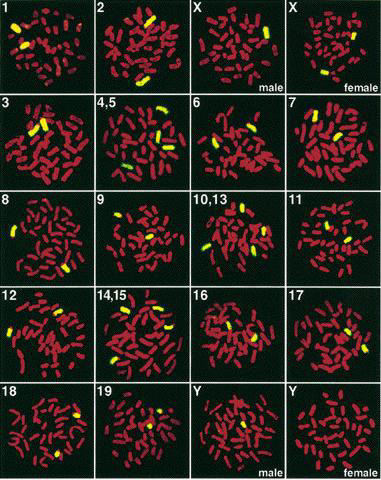 |
Cell
division
For reproduction,
all
cells need to copy their chromosomes exactly and pass on an identical
copy
to each daughter cell. (Of course rare "mistakes" occur -- cells
actually have evolved to favor rare mistakes. Why?)
Two different
mechanisms
do this in cells:
Bacterial cell
fission,
in which the circular chromosome is replicated.
Eukaryotic
cell
cycle, including Mitosis, in which multiple linear chromosomes are
separated and passed on.
Bacterial cell fission
Replication of the
chromosome
starts at the origin attached to the cell wall, near the midpoint of
the
cell. Replication occurs bidirectionally around the chromosome, as the
cell elongates. New replicating forks can start before the first cell
division
takes place; this phenomenon allows an extremely rapid rate of
reproduction.
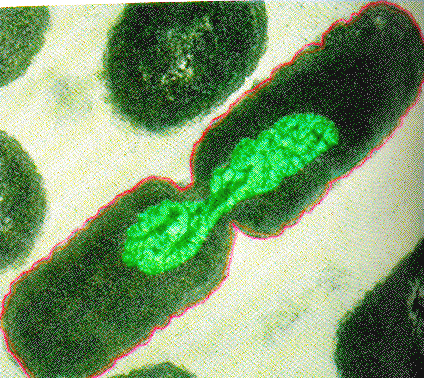
Eukaryotic cell
growth
In eukaryotes, DNA
replication actually occurs in S phase of interphase. Interphase: G1,
growth;
S, semiconservative synthesis of DNA; G2, preparation
for mitosis.
Mitosis only separates the newly
replicated chromosomes; DNA replication does not
occur
during mitosis.
The big problem
with
eukaryotes is that they have to replicate linear chromosomes with
special
ends called
telomeres. To do this, they need to use
a special enzyme called telomerase, actually related to the
reverse
transcriptase of HIV virus. Telomerase activity may play a
crucial
role in human aging; if the chromosome ends fail to replicate properly,
the chromosomes gradually lose parts of their end sequence.
For more
information
on telomerase, go
here.
Telomerase gene can
extend life of human cells, perhaps preventing aging! (Or will it
cause virulent cancer?)
Eukaryotic Cell
Division--Mitosis
Click
on picture for stages:
week01.htm
Trent
University, Biology Department
Mitosis
-- The Movie
Meiosis:
Division to
produce
sex cells
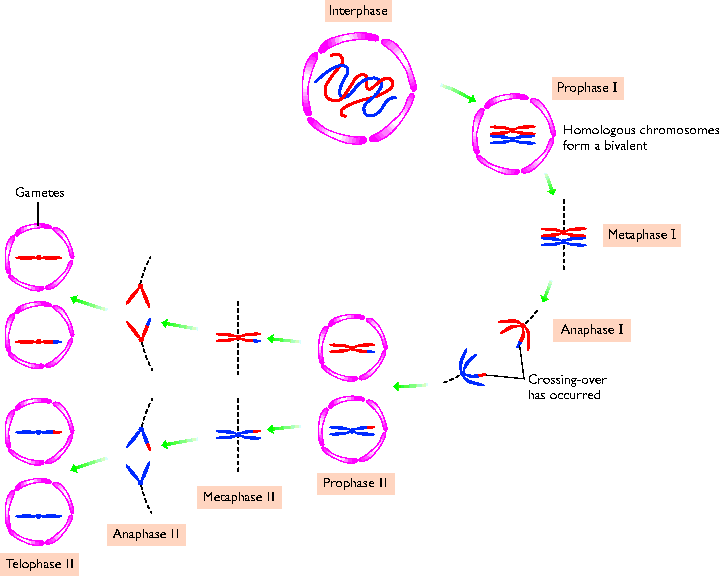
T.
A. Brown, Genomes, BIOS
What happens to
chromosome
copy number (ploidy) during DNA replication followed by mitosis or
meiosis?
Mitosis: 2N -> 4N
-> 2N
Meiosis: 2N -> 4N
-> 2N -> 1N
Problems:
(1)
Bacteria can divide TWICE in the time it takes to complete replication
of
their
entire circle of DNA. (This is one reason kids get sick so fast
after
eating
E.coli-contaminated
hamburger.)
How
is this possible? Can animal cells do the same thing? Why
or
why not?
(2)
Suppose that in a field of cells in tissue culture, about five percent
of cells show the condensed chromosomes of mitosis. If the duration of
mitosis is five minutes, what is the overall generation time of the
cells?
Solutions
>> Back
to Syllabus >>

 KAP WebNotes
KAP WebNotes

